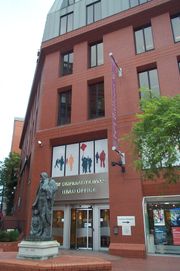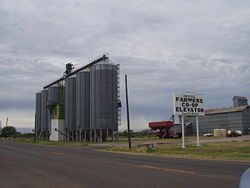Cooperative
2008/9 Schools Wikipedia Selection. Related subjects: Business; Community organisations
A cooperative (also co-operative or coöperative; often referred to as a co-op or coop) is defined by the International Co-operative Alliance's Statement on the Co-operative Identity as an autonomous association of persons united voluntarily to meet their common economic, social, and cultural needs and aspirations through a jointly-owned and democratically-controlled enterprise. A cooperative may also be defined as a business owned and controlled equally by the people who use its services or who work at it. Cooperative enterprises are the focus of study in the field of cooperative economics. Cooperatives have a sponsored top-level internet domain .coop, which identifies legally registered or recognized co-operatives.
History
Although co-operation as a form of individual and societal behaviour is intrinsic to human organisation, the history of modern co-operative forms of organising dates back to the Agricultural and Industrial Revolutions of the 18th and 19th centuries. The 'first co-operative' is under some dispute, but there were various milestones.
In 1761, the Fenwick Weavers' Society was formed in Fenwick, East Ayrshire, Scotland to sell discounted oatmeal to local workers. Its services expanded to include assistance with savings and loans, emigration and education. In 1810, social reformer Robert Owen and his partners purchased New Lanark mill from Owen's father-in-law and proceeded to introduce better labour standards including discounted retail shops where profits were passed on to his employees. Owen left New Lanark to pursue other forms of co-operative organisation and develop co-op ideas through writing and lecture. Co-operative communities were set up in Glasgow, Indiana and Hampshire, although ultimately unsuccessful. In 1828, William King set up a newspaper, The Cooperator, to promote Owen's thinking, having already set up a co-operative store in Brighton.
The Rochdale Society of Equitable Pioneers, founded in 1844, is usually considered the first successful co-operative enterprise, used as a model for modern co-ops, following the ' Rochdale Principles'. A group of 28 weavers and other artisans in Rochdale, England set up the society to open their own store selling food items they could not otherwise afford. Within ten years there were over 1,000 co-operative societies in the United Kingdom.
Other events such as the founding of a friendly society by the Tolpuddle Martyrs in 1832 were key occasions in the creation of organised labour and consumer movements.
Meaning
Cooperatives as legal entities
Although the term may be used loosely to describe a way of working, a cooperative properly so-called is a legal entity owned and democratically controlled equally by its members. A defining point of a cooperative is that the members have a close association with the enterprise as producers or consumers of its products or services, or as its employees.
In some countries, there are specific forms of incorporation for co-operatives. Cooperatives may take the form of companies limited by shares or by guarantee, partnerships or unincorporated associations. In the USA, cooperatives are often organized as non-capital stock corporations under state-specific cooperative laws. However, they may also be unincorporated associations or business corporations such as limited liability companies or partnerships; such forms are useful when the members want to allow:
- some members a greater share of the control, or
- some investors to have a return on their capital that exceeds fixed interest,
neither of which may be allowed under local laws for cooperatives. Cooperatives often share their earnings with the membership as dividends, which are divided among the members according to their participation in the enterprise, such as patronage, instead of according to the value of their capital shareholdings (as is done by a joint stock company.)
Co-operative identity
Cooperatives are based on the values of self-help, self-responsibility, democracy and equality. In the tradition of their founders, cooperative members believe in the ethical values of honesty, openness, social responsibility and caring for others. Such legal entities have a range of unique social characteristics. Membership is open, meaning that anyone who satisfies certain non-discriminatory conditions may join. Economic benefits are distributed proportionally according to each member's level of participation in the cooperative, for instance by a dividend on sales or purchases, rather than divided according to capital invested. Cooperatives may be generally classified as either consumer cooperatives or producer cooperatives.
Types of cooperatives
Housing cooperative
A housing cooperative is a legal mechanism for ownership of housing where residents either own shares (share capital co-op) reflecting their equity in the co-operative's real estate, or have membership and occupancy rights in a not-for-profit co-operative (non-share capital co-op), and they underwrite their housing through paying subscriptions or rent.
Housing cooperatives come in two basic equity structures:
- In Market-rate housing cooperatives, members may sell their shares in the cooperative whenever they like for whatever price the market will bear, much like any other residential property. Market-rate co-ops are very common in New York City.
- Limited equity housing cooperatives, which are often used by affordable housing developers, allow members to own some equity in their home, but limit the sale price of their membership share to that which they paid.
Building cooperative
Members of a building cooperative (in Britain known as a self-build housing co-operative) pool resources to build housing, normally using a high proportion of their own labour. When the building is finished, each member is the sole owner of a homestead, and the cooperative may be dissolved.
This collective effort was at the origin of many of Britain's building societies, which however developed into "permanent" mutual savings and loan organisations, a term which persisted in some of their names (such as the former Leeds Permanent). Nowadays such self-building may be financed using a step-by-step mortgage which is released in stages as the building is completed.
The term may also refer to worker co-operatives in the building trade.
Retailers' cooperative
A retailers' cooperative (known as a secondary or marketing co-operative in some countries) is an organization which employs economies of scale on behalf of its members to get discounts from manufacturers and to pool marketing. It is common for locally-owned grocery stores, hardware stores and pharmacies. In this case the members of the cooperative are businesses rather than individuals.
The Best Western international hotel chain is actually a retailers' cooperative, whose members are hotel operators, although it now prefers to call itself a "nonprofit membership association." It gave up on the "cooperative" label after some courts insisted on enforcing regulatory requirements for franchisors despite its member-controlled status.
Utility cooperative
A utility cooperative is a public utility that is owned by its customers. It is a type of consumers' cooperative. In the US, many such cooperatives were formed to provide rural electrical and telephone service as part of the New Deal. See Rural Utilities Service.
Worker cooperative
A worker cooperative or producer cooperative is a cooperative that is owned and democratically controlled by its "worker-owners". There are no outside owners in a "pure" workers' cooperative, only the workers own shares of the business, though hybrid forms in which consumers, community members or capitalist investors also own some shares are not uncommon. Membership is not compulsory for employees, but generally only employees can become members. However, in India there is a form of workers' cooperative which insists on compulsory membership for all employees and compulsory employment for all members. That is the form of the Indian Coffee Houses. This system was advocated by the Indian communist leader A. K. Gopalan.
Business and employment co-operative
Business and employment co-operatives (BECs) are a subset of worker co-operatives that represent a new approach to providing support to the creation of new businesses. Like other business creation support schemes, BECs enable budding entrepreneurs to experiment with their business idea while benefiting from a secure income. The innovation BECs introduce is that once the business is established the entrepreneur is not forced to leave and set up independently, but can stay and become a full member of the co-operative. The micro-enterprises thus combine to form one multi-activity enterprise whose members provide a mutually supportive environment for each other.
BECs thus provides budding business people with an easy transition from inactivity to self-employment, but in a collective framework. They open up new horizons for people who have ambition but who lack the skills or confidence needed to set off entirely on their own – or who simply want to carry on an independent economic activity but within a supportive group context.
Social cooperative
A particularly successful form of multi-stakeholder cooperative is the Italian "social cooperative", of which some 7,000 exist. "Type A" social cooperatives bring together providers and beneficiaries of a social service as members. "Type B" social cooperatives bring together permanent workers and previously unemployed people who wish to integrate into the labour market.
Social cooperatives are legally defined as follows:
- the objective is the general benefit of the community and the social integration of citizens
- type A cooperatives provide health, social or educational services
- those of type B integrate disadvantaged people into the labour market. The categories of disadvantage they target may include physical and mental disability, drug and alcohol addiction, developmental disorders and problems with the law. They do not include other factors of disadvantage such as race, sexual orientation or abuse
- various categories of stakeholder may become members, including paid employees, beneficiaries, volunteers (up to 50% of members), financial investors and public institutions. In type B co-operatives at least 30% of the members must be from the disadvantaged target groups
- the cooperative has legal personality and limited liability
- voting is one person one vote
- no more than 80% of profits may be distributed, interest is limited to the bond rate and dissolution is altruistic (assets may not be distributed)
A good estimate of the current size of the social cooperative sector in Italy is given by updating the official ISTAT figures from the end of 2001 by an annual growth rate of 10% (assumed by the Direzione Generale per gli Ente Cooperativi). This gives totals of 7,100 social cooperatives, with 267,000 members, 223,000 paid employees, 31,000 volunteers and 24,000 disadvantaged people undergoing integration. Combined turnover is around 5 billion euro. The cooperatives break into three types: 59% type A (social and health services), 33% type B (work integration) and 8% mixed. The average size is 30 workers.
Consumers' cooperative
A consumers' cooperative is a business owned by its customers. Employees can also generally become members. Members vote on major decisions, and elect the board of directors from amongst their own number. A well known example in the United States is the REI (Recreational Equipment Incorporated) co-op, and in Canada: Mountain Equipment Co-op.
The world's largest consumers' cooperative is the Co-operative Group in the United Kingdom, which offers a variety of retail and financial services. The UK also has a number of autonomous consumers' cooperative societies, such as the East of England Co-operative Society and Midcounties Co-operative. In fact the Co-operative Group is something of a hybrid, having both corporate members (most other consumers' cooperatives, as a result of its origins as a wholesale society), and individual retail consumer members.
Japan has a very large and well developed consumer cooperative movement with over 14 million members; retail co-ops alone had a combined turnover of 2.519 trillion Yen (21.184 billion US dollars [market exchange rates as of 11/15/2005]) in 2003/4. (Japanese Consumers' Co-operative Union., 2003).
Migros is the largest supermarket chain in Switzerland and keeps the cooperative society as its form of organization. Nowadays, a large part of the Swiss population are members of the Migros cooperative – around 2 million of Switzerland's total population of 7,2 million[1] , thus making Migros a supermarket chain that is owned by its customers.
Coop is another Swiss cooperative which operates the second largest supermarket chain in Switzerland after Migros. In 2001, Coop merged with 11 cooperative federations which had been its main suppliers for over 100 years. As of 2005, Coop operates 1437 shops and employs almost 45,000 people. According to Bio Suisse, the Swiss organic producers' association, Coop accounts for half of all the organic food sold in Switzerland.
EURO COOP is the European Community of Consumer Cooperatives.
Agricultural cooperative
Agricultural cooperatives are widespread in rural areas.
In the United States, there are both marketing and supply cooperatives. Agricultural marketing cooperatives, some of which are government-sponsored, promote and may actually distribute specific commodities. There are also agricultural supply cooperatives, which provide inputs into the agricultural process.
In Europe, there are strong agricultural / agribusiness cooperatives, and agricultural cooperative banks. Most emerging countries are developing agricultural cooperatives. Where it is legal, medical marijuana is generally produced by cooperatives.
A cooperative is a form of vertical integration and is similar to an Alliance.
Cooperative banking (credit unions and cooperative savings banks)

Credit Unions provide a form of cooperative banking.
In North America, the caisse populaire movement started by Alphonse Desjardins in Quebec, Canada pioneered credit unions. Desjardins wanted to bring desperately needed financial protection to working people. In 1900, from his home in Lévis, Quebec, he opened North America's first credit union, marking the beginning of the Mouvement Desjardins.
While they have not taken root so deeply as in Ireland or the USA, credit unions are also established in the UK. The largest are work-based, but many are now offering services in the wider community. The Association of British Credit Unions Ltd ( ABCUL) represents the majority of British Credit Unions. British Building Societies developed into general-purpose savings & banking institutions with "one member, one vote" ownership and can be seen as a form of financial cooperative (although many ' de-mutualised' into conventionally-owned banks in the 1980s & 1990s). The UK Co-operative Group includes both an insurance provider CIS and the Co-operative Bank, both noted for promoting ethical investment.
Other important European banking cooperatives include the Crédit Agricole in France, Migros and Coop Bank in Switzerland and the Raiffeisen system in many Central and Eastern European countries. The Netherlands, Spain, Italy and various European countries also have strong cooperative banks. They play an important part in mortgage credit and professional (i.e. farming) credit.
Cooperative banking networks, which were nationalized in Eastern Europe, work now as real cooperative institutions. A remarkable development has taken place in Poland, where the SKOK (Spółdzielcze Kasy Oszczędnościowo-Kredytowe) network has grown to serve over 1 million members via 13,000 branches, and is larger than the country’s largest conventional bank.
In Scandinavia, there is a clear distinction between mutual savings banks (Sparbank) and true credit unions (Andelsbank).
Federal or secondary cooperatives
In some cases, cooperative societies find it advantageous to form co-operative federations in which all of the members are themselves cooperatives. Historically, these have predominantly come in the form of cooperative wholesale societies, and cooperative unions. Cooperative federations are a means through which cooperative societies can fulfill the sixth Rochdale Principle, cooperation among cooperatives, with the ICA noting that "Co-operatives serve their members most effectively and strengthen the co-operative movement by working together through local, national, regional and international structures."
See Also: List of Co-operative Federations
Cooperative wholesale society
According to cooperative economist Charles Gide, the aim of a cooperative wholesale society is to arrange “bulk purchases, and, if possible, organise production.” The best historical example of this were the English CWS and the Scottish CWS, which were the forerunners to the modern Co-operative Group.
Cooperative Union
A second common form of co-operative federation is a co-operative union, whose objective (according to Gide) is “to develop the spirit of solidarity among societies and... in a word, to exercise the functions of a government whose authority , it is needless to say, is purely moral.” Co-operatives UK and the International Co-operative Alliance are examples of such arrangements.
Co-operative party
In some countries with a strong cooperative sector, such as the UK, cooperatives may find it advantageous to form a parliamentary political party to represent their interests. The British Co-operative Party and the Canadian Co-operative Commonwealth Federation are prime examples of such arrangements.
The British cooperative movement formed the Co-operative Party in the early 20th century to represent members of consumers' cooperatives in Parliament. The Co-operative Party now has a permanent electoral pact with the Labour Party, and has 29 members of parliament who were elected at the 2005 general election as Labour Co-operative MPs. UK cooperatives retain a significant market share in food retail, insurance, banking, funeral services, and the travel industry in many parts of the country.




